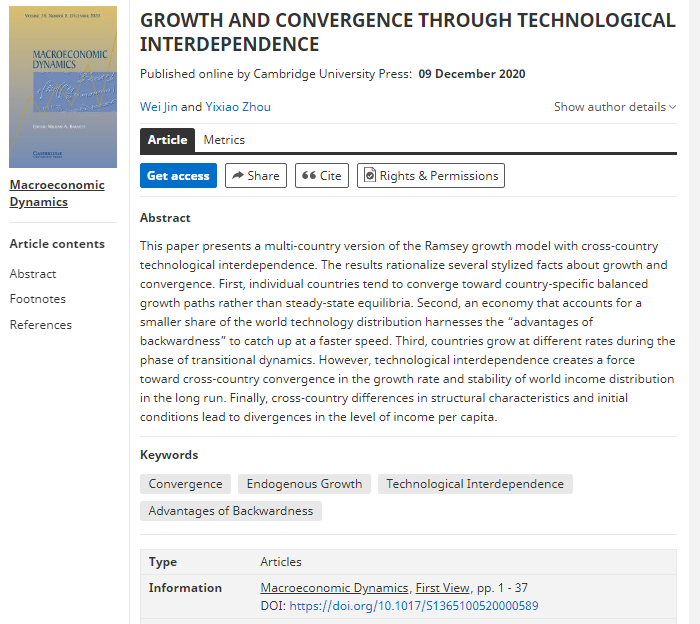时间:2020-12-15

Growth and Convergence through Technological Interdependence
Macroeconomic Dynamics, 2020
Wei Jin, Yixiao Zhou
Abstract:This paper presents a multi-country version of the Ramsey growth model with cross-country technological interdependence. The results rationalize several stylized facts about growth and convergence. First, individual countries tend to converge toward country-specific balanced growth paths rather than steady-state equilibria. Second, an economy that accounts for a smaller share of the world technology distribution harnesses the “advantages of backwardness” to catch up at a faster speed. Third, countries grow at different rates during the phase of transitional dynamics. However, technological interdependence creates a force toward cross-country convergence in the growth rate and stability of world income distribution in the long run. Finally, cross-country differences in structural characteristics and initial conditions lead to divergences in the level of income per capita.
摘要: 基于拉姆齐框架构建了一个刻画跨国技术依赖的多国经济增长模型,其分析结果可以解释有关经济增长和趋同的如下特征事实。首先,单个国家的经济增长趋向于该国特定的平衡内生增长路径,而不是趋向于稳态均衡。其次,在全球技术分配中所占份额较小的发展中国家可以利用所谓的“后发优势”吸收国际技术扩散,实现更快速度的技术进步和追赶。第三,不同国家在转型过渡阶段呈现出不同速度的经济增长。但是从长远来看,国家之间技术相互依赖和作用会推动实现增长率的跨国收敛以及世界收入分配的稳定。最后,由于各个国家在偏好,技术,禀赋等基本面特征以及发展初始条件存在区别,这也将导致人均收入水平在转型过渡以及远期平衡增长阶段都存在显著差异。
研究意义: 高度全球化的世界经济显示出各个国家技术相互依存的总体趋势。在技术相互依赖的世界经济中,单个国家的技术进步和经济增长不仅是其自身基本面的直接结果,而且也取决于所有其他技术依存国家的经济技术特征。为描述这一客观现实,本研究基于拉姆齐框架构建了一个刻画跨国技术依赖的多国经济增长模型。在该框架中,世界技术进步取决于所有技术依存国家的创新,而不是单个前沿国家的技术变化。采用这一全新分析框架,本研究从理论解析,数值模拟和实证检验多个角度考察了在技术相互依存情况下的经济增长和趋同,并解释了一系列增长趋同的特征事实。相比于单个技术前沿国家的单向技术扩散模型(如Nelson & Phelps, 1966; Parente & Prescott, 1994; Chu et al., 2014; Stokey, 2015),本文所提出的技术依存多国增长模型能够更好解释全球化背景下增长与趋同的现实特征。
文章全文参见链接: